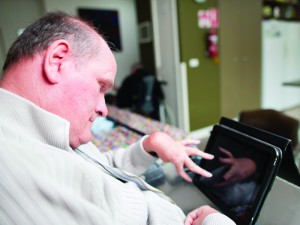The rollout of the NDIS has been welcomed by many, but there’s still a long way to go
If there was one aspect of disability care in Australia that was widely, even universally accepted, it was this: the system – in the state it was in – was nothing short of a shambles.
Anyone in doubt would do well to take a look at the Productivity Commission findings of 2011 that laid bare its deficiencies and inadequacies.
The Disability Care and Support Inquiry dissected its subject matter in close to 1000 pages, before drawing the inevitable and withering conclusion that provision for some of the country’s most disadvantaged people was in disarray.
In a summary that has become synonymous with the issue of disability care, the Productivity Commission labelled support arrangements “inequitable, underfunded, fragmented and inefficient”, offering people with disabilities little or no choice. So broken was the care and support system, the report even suggested it could hardly be described as a system at all.
Little wonder then, that reform of such an antiquated structure – through the formation of the National Disability Insurance Scheme (NDIS) that will double disability care and support funding – was so warmly welcomed, as well as so desperately needed.
Partially funded through a 0.5% rise in the Medicare levy, the NDIS has been variously described as a “once in a generation reform”, “ground-breaking” and “the most significant social reform since Medicare”.
The National Disability Insurance Agency (NDIA), which oversees the scheme, has just completed the third and final year of a trial phase at a number of locations around Australia with a full national roll-out now underway. That it won’t become fully operational until July 2019 goes some way to illustrate the magnitude of the task at hand.
“Make no mistake, this has and will continue to have a huge impact for people with disabilities and their families. There is no walking away from that,” said Jo-Anne Hewitt, general manager of client services at Cerebral Palsy Alliance.
At the core of the NDIS is a fundamental shift in ideology that will progressively see provision for people with disabilities move from a welfare model to one of consumer empowerment.
The days are numbered of the block-funded, rigidly administered, one-size-fits-all approach where diverse needs are, in the main, overlooked and support rarely more than a “postcode lottery”.
In its place is a scheme that champions flexibility, choice and control with the creation of funding packages tailored to the specific needs and desires of individuals.
Plans, or “goals”, are drawn up by the individuals themselves, often with the help of advocacy groups or NDIA-appointed Local Area Coordinators, and funding is provided to help meet those goals. Packages are updated and renewed every 12 months as the needs or circumstances of the participant changes.
“We have seen people who had no support because the previous funding scheme was unable to accommodate them, now receiving support they require to stay at home and live a relatively normal life,” said Susan Tame, senior manager at MS Care, which provides support for people with multiple sclerosis.
“We have seen more than 400 people with MS have their lives turned around through the NDIS through equipment and personal support so they can get out of bed in the morning, get in the shower, and get off to work.
“Some of them would have received help before, but others have had nothing for years.”
During the NDIS trial period, 36,700 people were successfully admitted to the scheme out of 41,500 requests. When the national rollout is complete in almost three years’ time, the number of people with disabilities receiving packages is expected to hit 460,000.
Professor Christine Bigby, director of Living with Disability Research Centre at La Trobe University in Melbourne, said the long overdue reform signalled a fundamental shift in approach towards care.
“We are moving from welfare paternalism where we care for people with disabilities to recognising that people with disabilities are people with rights, who, with the right support, can continue to participate in society and play important roles,” she told The Medical Republic.
“The whole thrust is a move to individualised funding which gives people more control and choice over how and what sort of support they get.”
Hewitt, from the Cerebral Palsy Alliance, said while the NDIS might be new in practice, the ideological concept had been long discussed in disability circles, and the scheme was the “systemic expression” of that ideology.
“If you talk to people in the disability sector, the notion of choice and control, individualisation and person-centredness has been around for a long time, but there has not been the funding system or the social policy that sits behind it,” she explained. “This has been a long time coming.”
Such a view was backed by Carmel Laragy, senior research fellow with the Centre for Applied Social Research at Melbourne’s RMIT University, who said the inception of the NDIS had its roots in an international trend to put consumers in control.
She described the ideological shift as an “inevitable step”, driven by growing calls for people with disabilities to be afforded the same rights as the able bodied.
The rationed, get-what-you’re-given service model, with no recourse for recipients, was just no longer viable, she said.
“The old model was very restrictive with no flexibility, and in a world where everything is mobile and flexible, we want responses to our needs,” Laragy said.
“If we need a service, we are no longer going to accept being told ‘we are not going to tell you how much has been allocated to you, you have to accept what services we have and you can’t go anywhere else’. It was a model that had outgrown its time.”
However, Professor Karen Fisher, from the social policy research centre at the University of New South Wales, said that while the need for reform was clear, some in the profession had needed convincing.
“Many people with a professional and personal interest in the previous system had to be persuaded to change,” she said.
“Whenever change comes about, people take it as a criticism of what has happened in the past – which implicitly it is – and there is a pot of emotion in disability because that implies we were not doing the right thing by people with disabilities in the past.
“There has been state government commitment for 30 years to close institutions yet we still have 5000 people across Australia living in institutions and that is just outrageous and embarrassing.
“You say that in the UK, and they say, ‘What? You have got to be kidding’.”
So far, Fisher said, the NDIS deserved “a big tick”.
But just who is eligible for NDIS funding?
According to the NDIA, packages are designed to provide “reasonable and necessary” support for people with “permanent and significant” disabilities.
It is not means tested or limited to specific illnesses or conditions, and available to anyone whose disability “substantially reduces their ability to take part effectively in activities [including] communication, social interaction, learning, mobility, self-care or self-management, or perform tasks or actions”.
Furthermore, once in the NDIS system, you are supported for life.
At the end of the trial period, $2.4 billion worth of funds had been committed, with around 50% distributed to just 9% of participants who received annualised packages of more than $100,000. The majority, 71%, received annual packages of under $30,000. The NDIA claims the trial phase has been a resounding success.
“The NDIA has demonstrated its capacity and capability to deliver through the three-year NDIS trial,” a spokeswoman said. “The trial was delivered on time and on budget, with 95% of participants describing their experience in the scheme as either good or very good.”

Emerging issues
That, however, is far from the full story. For a scheme that has such profound implications for both its users and those who provide the services, it is perhaps inevitable that problems have emerged.
Everyone, including NDIS “planners” who are responsible for approving applicants and their packages, are learning as they go.
For the beneficiaries of funding, while establishing needs and goals may on the surface seem straightforward enough, both the creation of a plan and its implementation have been described as daunting.
MS Care’s Tame said her organisation had a checklist on its website, and supported participants in the pre-planning stage to help them think about what goals they might want to achieve.
“It’s a complete shift in mindset,” she said. “Before the NDIS, people with disabilities had no choice or say in how, when or if they would get the support they needed.
“One thing we have noticed is the people who we work with in the pre-planning stage tend to get better outcomes and better packages. People are just not used to thinking through their impairments in terms of goals.
“In the past someone may have said ‘I’m having problems with my mobility and I need some physio’. Now they are saying ‘my goal is to get back out into the community, or go to Geelong footy matches, or my goal is to get a job’.
“It’s a totally different way of thinking.”
Tame also stressed the need for support co-ordination to be built into every package, a service that helped people activate their plan once it had been approved.
Worryingly, according to Tame, the scheme seems to have stepped back from the policy of including such support in every package.
“In the first year of NDIS, not many had support co-ordination and people would get nine months into their plan and hadn’t received any services because they had this big piece of paper that was just confusing and meant nothing to them,” she said.
“So they started putted support plan co-ordination in every plan for people living with MS. We saw really fantastic results and people getting their plans active straight away.
“Now, as it rolls out nationally, we are seeing support co-ordination go into some plans and not others. That worries us because we think it needs to be in every single plan. People need that support at least in the first year to get their plans active.”
Laragy said research conducted with parents at a trial area in Barwon in New South Wales also highlighted difficulties during the planning stage, at least initially, both for participants and planners.
“They said when they went for their first meeting they didn’t know which way was up,” she said.
“They didn’t know what to ask for, and ended up coming away with only a little support.
“But in the second year, my God did they get geared up. They joined advocacy groups, took an advocate with them, and had a list of things they wanted. They came away with so much more.
“It’s a huge change. Telling people with disabilities what to do is out of the door. It’s now a case of people saying to planners ‘you can be my assistant’.
“We have a system now that is being driven by people with disabilities and their families. Five or six years ago they wouldn’t have dreamed this could happen.
“The momentum and understanding is growing.”


